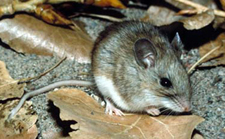
SHARE THIS ARTICLE:
Study Reveals Some Tick-Borne Pathogens Found in Fleas

In a recent study conducted in central Pennsylvania, evidence of emerging pathogens, some also common to ticks, have been found in fleas. Various pathogens can be spread by ectoparasites among animal host populations in nature. Along with ticks, fleas are found to commonly infest small mammals. The role of pathogen transmission cycles for these vectors is unknown.
In this study, small mammals were captured and fleas were collected in an effort to better understand the enzootic cycle of flea‐borne pathogens in central Pennsylvania. Pathogen testing was conducted in both the small mammal hosts and the fleas collected.
Seven species of small mammals were captured of which white‐footed mice (Peromyscus leucopus) and southern red‐backed voles (Myodes gapperi) accounted for over 94% of the captures. Only P. leucopus tested positive for the blood‐borne pathogens examined, with 47 (18.1%) positive for Anaplasma phagocytophilum and ten (4.8%) positive for Babesia microti.
Of the 61 fleas collected from small mammals and tested for pathogens, Orchopeas leucopus was the most common flea species. Pathogenic bacteria and parasites were detected in 33.3% of total fleas collected, and included Bartonella vinsonii subspecies arupensis, B. microti, and a Rickettsia felis‐like bacterium. Researchers believe this to be the first report of B. microti DNA detected from a flea, as well as the first report of a R. felis‐like bacterium from rodent fleas in eastern North America.
At this time, only plague (Yersinia pestis) is a nationally reportable flea-borne disease in the United States. Like tick-borne diseases, under-reporting of flea-borne illnesses limits understanding of the burden of disease from these vectors. The potential for new and re‐emerging pathogens in fleas as well as the potential for fleas to play a role in natural transmission cycles of tick‐borne pathogens is not understood. This study elucidates that further investigation is needed to understand the ecology of flea‐borne disease transmission cycles, vector competence of fleas for tick-borne pathogens, and the risk to human health.
Read full article: Host distribution and pathogen infection of fleas (Siphonaptera) recovered from small mammals in Pennsylvania





